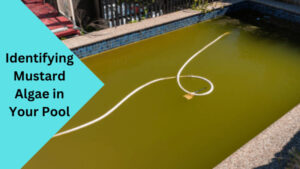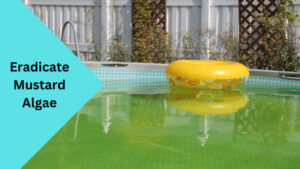Having a sparkling, inviting pool is the dream of every pool owner. However, the presence of mustard algae can turn that dream into a pool owner’s worst nightmare. In this comprehensive guide, we will delve into all things mustard algae and provide you with the knowledge and tools you need to eradicate this persistent pool problem. From identifying mustard algae to effective treatment solutions, we’ve got you covered.
Mustard algae is a stubborn type of pool algae that can take hold in your pool, turning the water cloudy and creating unsightly yellow or mustard-colored patches on surfaces. But fear not! With the right techniques and consistent maintenance, you can bid farewell to mustard algae and enjoy a pristine pool once again. Let’s dive in!
- Understanding Mustard Algae
- Identifying Mustard Algae in Your Pool
- How to Get Rid of Mustard Algae in Pool
- Mustard Algae or Pollen: Spotting the Difference
- Mustard Algae or Sand: Identifying the Culprit
- Preventing Mustard Algae in Your Pool
- Mustard Algae Treatment for Different Pool Surfaces
- Tips for a Hassle-Free Mustard Algae Clean-up
- Mustard Algae Killer: Effective Products and Recommendations
- Maintaining a Mustard Algae-Free Pool
- Frequently Asked Questions (FAQs)
- Conclusion
Understanding Mustard Algae
Before we delve into the eradication methods, let’s first understand what mustard algae is. Mustard algae (also known as yellow algae) is a type of chlorine-resistant algae that can thrive in pool water even when the chemical levels are within the recommended range. It is commonly found in poorly maintained or neglected pools, especially if the water is warm and the pool lacks proper circulation. Mustard Algae: Causes, Prevention, and Effective Treatment
Identifying Mustard Algae in Your Pool

One of the keys to successfully eradicating mustard algae is early detection. To help you identify mustard algae in your pool, here are the key signs to look out for:
- Yellow or Mustard-Colored Filamentous Patches: Mustard algae typically appears as small clusters of fine, mustard-colored spots on the pool surfaces, such as walls, steps, and even pool toys.
- Low Clingability: Unlike other types of algae that can be easily brushed off, mustard algae tends to stick to surfaces, even after brushing.
- Resisting Chlorine Treatment: Mustard algae is notorious for being resistant to normal chlorine levels. If your pool water doesn’t respond to regular chlorination, it could be a sign of mustard algae presence.
How to Get Rid of Mustard Algae in Pool
Eradicating mustard algae from your pool requires a systematic approach. By following these steps, you can effectively eliminate mustard algae and prevent its return:
Manual Brushing and Vacuuming
- Brush all affected pool surfaces vigorously to dislodge the mustard algae.
- Vacuum the pool thoroughly to remove the dislodged algae and prevent recont.
Super chlorination
- Shock your pool with a high dose of chlorine to kill the algae.
- Maintain a high chlorine level for an extended period to ensure complete eradication.
Algaecide Treatment
- Choose a suitable algaecide specifically designed for mustard algae.
- Follow the manufacturer’s instructions and apply the algaecide as directed.
Filtration System Cleaning
- Backwash or clean your pool’s filtration system to remove any trapped algae.
- Consider adding a filter aid to enhance the efficiency of the filtration process.
Remember, consistency is key when treating mustard algae. Be patient and allow ample time for the treatment to be effective.
Mustard Algae or Pollen: Spotting the Difference
Many pool owners confuse mustard algae with pollen, as they can have similar yellowish appearances. However, understanding the differences between the two can help you take appropriate actions. Here’s a comparison:
- Mustard Algae: Appears as small, yellow clusters that stick to pool surfaces. It won’t disperse or dissolve easily when touched or brushed.
- Pollen: Presents as a yellow film on the water’s surface, and it can disperse or dissolve quickly when disturbed.
If unsure, perform the “sock test” to determine if the particles are algae or pollen. Dip a white sock or a fine-mesh net into the pool water, and if you collect the particles, it’s likely mustard algae. However, if the particles pass through the sock or net, it’s more likely to be pollen.
Mustard Algae or Sand: Identifying the Culprit
Sometimes, mustard algae can be easily mistaken for sand particles due to their similar appearance. To differentiate between the two, observe the following characteristics:
- Mustard Algae: Clusters of yellow particles that stick to pool surfaces, such as walls or steps. They won’t disperse or dissolve easily.
- Sand: Granules that settle on the bottom of the pool and can be easily stirred up or moved by water movement.
Knowing the distinction is crucial in addressing the issue correctly. If you suspect mustard algae, follow the appropriate treatment methods discussed earlier.
Preventing Mustard Algae in Your Pool
Prevention is the best defense against mustard algae returning to your pool. By implementing these proactive measures, you can minimize the chances of another outbreak:
Regular Maintenance and Filtration
- Perform routine pool maintenance, including brushing, vacuuming, and skimming debris.
- Clean and backwash your pool’s filtration system regularly to ensure optimal performance.
Proper Pool Chemistry
- Maintain proper water balance by regularly testing and adjusting pH, alkalinity, and chlorine levels.
- Use a reliable pool testing kit to ensure accurate readings and take appropriate actions.
Effective Pool Circulation
- Run your pool’s circulation system for an adequate duration to ensure proper water flow and filtration.
- Consider investing in additional circulation equipment, such as a pool cleaner or better water jets.
Sunlight and Shade Management
- Control the amount of direct sunlight hitting your pool to prevent algae growth. Use pool covers or shade structures if necessary.
- Ensure the pool area has adequate sunlight and ventilation to discourage algae growth.
By following these preventive tips, you can significantly reduce the likelihood of mustard algae reappearing in your pool.
Mustard Algae Treatment for Different Pool Surfaces
Different pool surfaces may require specific strategies when treating mustard algae. Here’s how to tackle mustard algae based on your pool’s surface material:
Concrete Pools
- Brush vigorously using a stiff-bristle brush to dislodge algae.
- Vacuum your pool thoroughly to remove the loosened algae.
- Scrub the affected areas with a suitable algaecide, ensuring even coverage.
Vinyl Pools
- Use a soft-bristle brush or a nylon brush to scrub vinyl pool surfaces gently.
- Vacuum the pool, making sure to remove all dislodged algae.
- Apply a vinyl-safe algaecide according to the manufacturer’s instructions.
Fiberglass Pools
- Use a soft-bristle brush to gently scrub the affected areas.
- Vacuum the pool carefully to prevent damage to the fiberglass surface.
- Use a fiberglass-safe algaecide and follow the instructions provided.
Adapting the treatment methods to your pool’s surface ensures efficient and safe eradication of mustard algae.
Tips for a Hassle-Free Mustard Algae Clean-up
While tackling mustard algae, consider these additional tips to make the process smoother and more effective:
- Avoid Pool Shock Overkill: While super chlorination is essential, avoid using excessively high chlorine doses, as it may damage your pool surfaces and equipment.
- Take Preventive Measures during Travel: If you plan to be away from home for an extended period, ensure your pool is adequately maintained or protected to prevent algae growth.
- Monitor Water Chemistry Regularly: Keep a close eye on your pool’s water chemistry and adjust chemical levels as needed to create an environment inhospitable to algae growth.
- Pay Attention to Corners and Crevices: Mustard algae often hides in hard-to-reach areas. Pay extra attention to corners, crevices, and tight spots while performing cleaning and treatment.
- Consider Enlisting Professional Help: If mustard algae keeps recurring despite your efforts, consulting a pool professional can provide valuable insights and guidance.
Mustard Algae Killer: Effective Products and Recommendations
To effectively combat mustard algae, various commercial algaecides, natural remedies, and DIY solutions are available. Here are some recommendations to help you choose the best option for your needs:
Commercial Algaecides
- “Brand X Mustard Algae Killer” – A highly recommended algaecide that specifically targets mustard algae.
- “Brand Y Super Algae Terminator” – A powerful algaecide suitable for mustard algae prevention and treatment.
Remember to follow the manufacturer’s instructions when using any commercial algaecides.
Natural Remedies
- Vinegar – A natural cleaning agent, vinegar can help control mustard algae. Mix equal parts vinegar and water and scrub affected areas.
- Baking Soda – Known for its ability to raise pH levels, baking soda can disrupt the growth of mustard algae. Apply a baking soda-water solution to affected areas.
DIY Mustard Algae Solutions
- Borax – A Borax-water solution can help eliminate mustard algae. Dilute 1 cup of Borax in 1 gallon of water and scrub the affected areas.
- Bleach – A chlorine bleach-water solution can be effective against mustard algae. Use caution and follow proper safety guidelines.
As with any treatment, test the product or solution on a small inconspicuous area before applying it extensively to ensure compatibility and safety.
Maintaining a Mustard Algae-Free Pool
Now that you’ve successfully eradicated mustard algae, it’s crucial to maintain a clean and healthy pool environment to prevent future outbreaks. Here are some pointers for long-term maintenance:
Regular Testing and Water Balancing
- Keep testing your pool water regularly to maintain optimal pH, chlorine, and alkalinity levels.
- Adjust chemical levels as necessary and maintain proper water balance for an algae-resistant pool.
Proper Pool Cleaning Routine
- Establish a regular cleaning routine, including brushing, vacuuming, and skimming debris.
- Pay attention to the pool’s corners, crevices, and hard-to-reach areas during cleaning sessions.
Monitoring Pool Contaminants
- Regularly check for signs of algae growth, unusual pool discoloration, or any changes in water clarity.
- Take immediate action if you notice any red flags to prevent a potential algae outbreak.
Remember, a proactive and diligent approach to maintenance is key to ensure your pool remains dazzling and algae-free.
Frequently Asked Questions (FAQs)
How does mustard algae spread in a pool?
Mustard algae can enter your pool through various sources, such as contaminated swimwear, toys, or windblown debris. It can quickly spread if not addressed promptly, as it has a high resistance to chlorine.
Can mustard algae survive in cold water?
Mustard algae can survive in both warm and cold water, although it tends to thrive better in warmer temperatures. Cold water can slow down its growth, but it doesn’t guarantee eradication.
Is mustard algae harmful to humans?
Mustard algae itself is not considered harmful to humans. However, its presence may indicate poor water maintenance or potential issues with other contaminants that could pose health risks.
How long does it take to get rid of mustard algae?
The time needed to completely eliminate mustard algae depends on various factors, such as the severity of the infestation, treatment methods used, and the consistency of maintenance. It can take anywhere from a few days to a couple of weeks.
Conclusion
Eradicating mustard algae from your pool can be a challenging task, but armed with the right knowledge and methods, you can achieve a sparkling, algae-free oasis. By identifying mustard algae early, following proper treatment techniques, and implementing preventive measures, your pool can remain a refreshing sanctuary for years to come. Remember to stay vigilant, conduct regular maintenance, and seek professional advice if needed. Say goodbye to mustard algae troubles and hello to crystal-clear waters!

Greetings, fellow pool enthusiasts! I’m Turner Davis, your dedicated guide to the world of pool care and maintenance. With over a decade of experience in the field, I’ve made it my mission to transform ordinary pools into extraordinary aquatic retreats.

